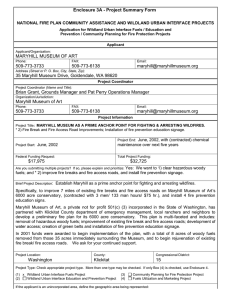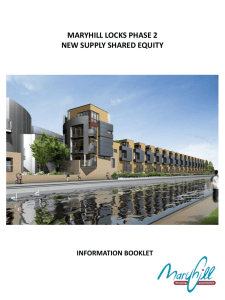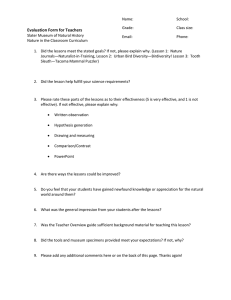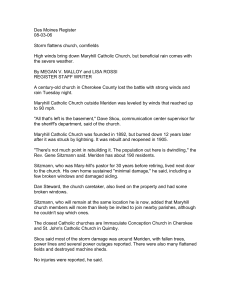NATIONAL FIRE PLAN COMMUNITY ASSISTANCE AND WILDLAND URBAN INTERFACE PROJECTS
advertisement
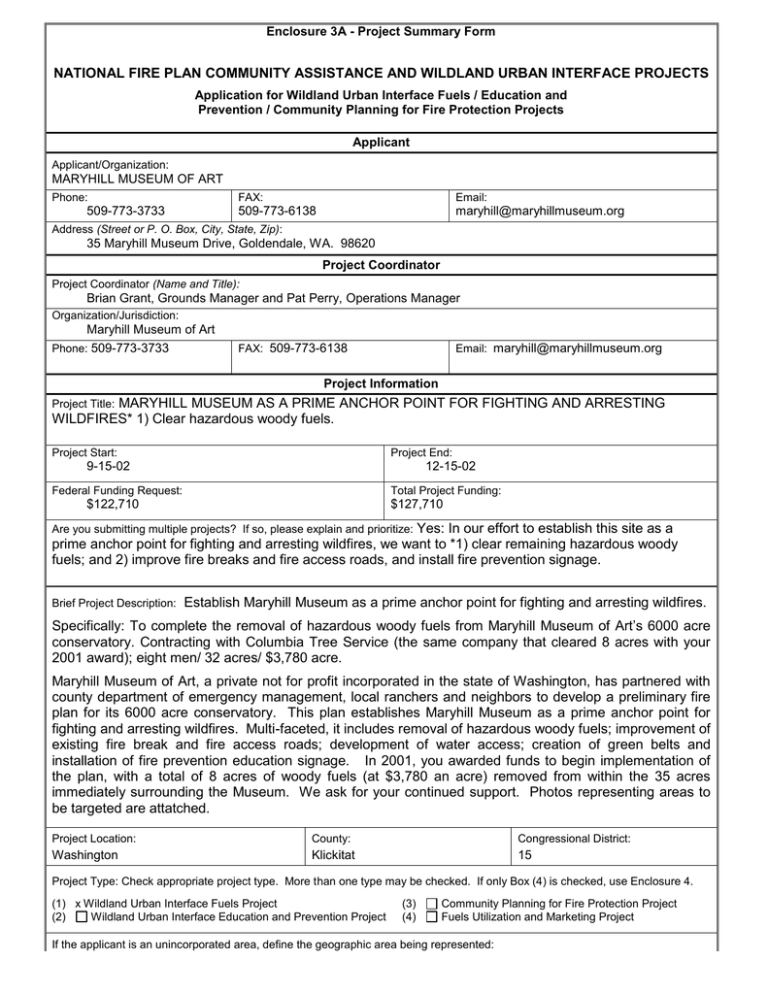
Enclosure 3A - Project Summary Form NATIONAL FIRE PLAN COMMUNITY ASSISTANCE AND WILDLAND URBAN INTERFACE PROJECTS Application for Wildland Urban Interface Fuels / Education and Prevention / Community Planning for Fire Protection Projects Applicant Applicant/Organization: MARYHILL MUSEUM OF ART Phone: 509-773-3733 FAX: Email: 509-773-6138 maryhill@maryhillmuseum.org Address (Street or P. O. Box, City, State, Zip): 35 Maryhill Museum Drive, Goldendale, WA. 98620 Project Coordinator Project Coordinator (Name and Title): Brian Grant, Grounds Manager and Pat Perry, Operations Manager Organization/Jurisdiction: Maryhill Museum of Art Phone: 509-773-3733 FAX: 509-773-6138 Email: maryhill@maryhillmuseum.org Project Information MARYHILL MUSEUM AS A PRIME ANCHOR POINT FOR FIGHTING AND ARRESTING WILDFIRES* 1) Clear hazardous woody fuels. Project Title: Project Start: Project End: 9-15-02 12-15-02 Federal Funding Request: Total Project Funding: $122,710 $127,710 Yes: In our effort to establish this site as a prime anchor point for fighting and arresting wildfires, we want to *1) clear remaining hazardous woody fuels; and 2) improve fire breaks and fire access roads, and install fire prevention signage. Are you submitting multiple projects? If so, please explain and prioritize: Brief Project Description: Establish Maryhill Museum as a prime anchor point for fighting and arresting wildfires. Specifically: To complete the removal of hazardous woody fuels from Maryhill Museum of Art’s 6000 acre conservatory. Contracting with Columbia Tree Service (the same company that cleared 8 acres with your 2001 award); eight men/ 32 acres/ $3,780 acre. Maryhill Museum of Art, a private not for profit incorporated in the state of Washington, has partnered with county department of emergency management, local ranchers and neighbors to develop a preliminary fire plan for its 6000 acre conservatory. This plan establishes Maryhill Museum as a prime anchor point for fighting and arresting wildfires. Multi-faceted, it includes removal of hazardous woody fuels; improvement of existing fire break and fire access roads; development of water access; creation of green belts and installation of fire prevention education signage. In 2001, you awarded funds to begin implementation of the plan, with a total of 8 acres of woody fuels (at $3,780 an acre) removed from within the 35 acres immediately surrounding the Museum. We ask for your continued support. Photos representing areas to be targeted are attatched. Project Location: County: Congressional District: Washington Klickitat 15 Project Type: Check appropriate project type. More than one type may be checked. If only Box (4) is checked, use Enclosure 4. (1) x Wildland Urban Interface Fuels Project (2) Wildland Urban Interface Education and Prevention Project (3) (4) Community Planning for Fire Protection Project Fuels Utilization and Marketing Project If the applicant is an unincorporated area, define the geographic area being represented: Enclosure 3B (Page 1 of 3) - Project Narrative Description Applications for funding must include a narrative response that describes the proposal. Please do not submit responses longer than one page, single space, 12-pitch font. Describe project including, but not limited to: project location Address these project implementation items as anticipated outcomes applicable: measures and reporting partners project income project time frames specify types of activities and equipment used amount or extent of actions (acres, number of homes, etc) environmental, cultural and historical resource requirements Response: LOCATION: Maryhill Museum of Art, a private not for profit 501 (c) (3) organization, is located in an unincorporated rural area of south central Washington on State Scenic Route 14, which it intersects between mile post 98.3 and 102. The Museum manages a 6,000-acre conservatory of open rangeland, with residencies and outbuildings - used in association with cattle grazing operations - that are surrounded by aging and unpruned trees and large shrubs. The property is also freckled with gullies, hollows and springs overgrown with old and dying trees and tangled with bushes, some of which are only feet from Route 14. These untreated fuels feed wind driven wildfires that rage through each year *, endangering lives and destroying wildlife, fencing, water systems, crops and trees, and interrupting traffic. The urgency of the problem has been compounded by the severe drought conditions our region has suffered the past years. PARTNERS: In 2001 you awarded Maryhill funding to begin implementation of a community fire protection plan, developed in partnership with an advisory committee made up of local fire district officials, the Klickitat County Department of Emergency Management and nearby residents, with the Yakama Nation invited to participate. These funds were used to mechanically remove hazardous fuels from a total of 8 acres of aging trees and shrubs on the 35 acres immediately surrounding the Museum, and to begin the rejuvenation of existing fire breaks/ fire access roads across Maryhill lands. IMPLEMENTATION, ACTIVITIES, TIME FRAME: We ask for your further support in the amount of $122,710 to continue implementation of the fire protection plan. Continuing with the business with whom we contracted in 2001, funds will be used between September 15 - December 15 2002 to complete the mechanical removal of hazardous woody fuels from the Museum’s holdings. A total of 32 acres, constituting much of what remains to be removed over the entire 6000 acres, will be targeted (at $3,780 per acre, the same cost per acre awarded for 2001 project). Targeted areas include hi-way 14 (which intersects the property); around leased residencies; the Loops Road and accessible springs, gullies and hollows. OUTCOMES: This completed plan will position Maryhill Museum as an anchor point for fighting and arresting wildfires. Outcomes of this project will greatly reduce the potential and severity of future fires, provide improved fire protection for residents and nearby communities, and people traveling over hi-way 14; safeguard historic and venerated sites; improve the health of trees and wildlife, and strengthen interagency coordination. MEASURES AND REPORTING: Maryhill keeps data on fires. We will measure historical severity with the expected diminished severity of future fires and report as needed. INCOME: This project will not generate any income. ENVIRONMENTAL, CULTURAL AND HISTORICAL: This project will not include ground-disturbing activities, and will improve wildlife habitat. *Fire date: Acres burned: Fire date: Acres burned: 6/22/99 5 6/21/00 1000 7/4/99 2 7/14/00 10 8/15/99 40 8/19/00 250 9/6/99 2500 9/18/00 5 and 450 4/5/00 1 9/27/00 5 8/18/01 27 Enclosure 3B (Page 2 of 3) - Project Evaluation Criteria Applications for funding must include narrative responses that address the following four criteria. Within each criterion, subcriteria are listed in descending order of importance. Limit your responses to the areas provided. 1. Reducing Fire Risk. (40 points)) A. Describe how the proposal promotes reduction of risk in high hazard areas or communities. B. Describe how the proposed project benefits resources on federal land or adjacent non-federal land, or how it protects the safety of communities. C. To what extent does the project implement or create a cooperative fuels treatment plan or community fire strategy (include evidence of the plan if it already exists)? D. Explain to what extent the affected community or proponent has been involved or plans to involve the affected community in a qualified fuels education program (e.g., FIREWISE). E. Explain how the proposal (a) leads to, enhances or restores a local fire-adapted ecosystem, and/or (b) mitigates or leads to the mitigation of hazardous fuel conditions. F. How will the proposed treatments be maintained over time? Response: A & B: Removal of fuels will reduce the frequency and voracity of wildfires, thereby providing nearby homes, communities and adjacent non-federal lands with immediate improved protection. C: Building on the county’s emergency management plan, this project will continue with the implementation of the existing community fire plan. D: Maryhill has committed to making space available for FIREWISE educational signage at those locations on the grounds most visited by the public. This includes the Museum, Stonehenge Memorial, Loops Road area, and Hiway 97 overlook. E: Removing fuels reduces the fuel load and improves the health of the ecosystem. F: Those living trees needing pruning will be pruned, then maintained as needed. Chemicals will be used (as minimally as possible) to retard new growth as needed. 2. Increasing local capacity. (30 points) A. How would the proposal improve or lead to the improvement of the local economy in terms of jobs and sustainable economic activity? How many jobs are expected to be created or retained and for how long (please distinguish between essentially yearround and seasonal jobs)? B. To what extent will this project be offered to serve as a model for other communities? C. Will biomass or forest fuels be utilized; if so, in what manner and how much? Response: A: We will continue to contract this work out with the same company that worked with us on the 2001 project. This will be seasonal work and take eight people approximately ten weeks. B: We would be honored to make this project available as a model as needed. Maryhill staff is often invited to speak on local news radio, where we discuss the plan and the progress made. C: Pruned wood will be offered (at no cost) as firewood to community members, with unusable wood and other debris converted to mulch. Enclosure 3B (Page 3 of 3) - Project Evaluation Criteria 3. Increasing interagency and intergovernmental coordination. (15 Points) A. Describe how this project implements a local intergovernmental strategy plan, or creates such a plan. Describe the plan if it already exists. B. Explain the level of cooperation, coordination or strategic planning among federal, state, tribal, local government and community organizations. List the cooperators. Response: A: A preliminary fire plan has been developed by the Community Fire Plan Advisory Committee (listed below). This plan includes removal of hazardous woody materials; improving fire breaks and fire roads with installation of gates and locks; water access development; creating living green belt fire breaks and installing educational signage within the 6000 acre Maryhill holdings. B: Maryhill is part of an existing partnership made up of an advisory committee who meet on a monthly basis to review all land related issues – including fire prevention – involving Museum property. In addition to enjoying and maintaining active communication with officials of the local fire district as well as the Klickitat County Department of Emergency Management, Maryhill staff has worked with the US Fish and Wildlife in implementation of the first phase of the Fire Plan. Maryhill enjoys a strong level of cooperation. Our Community Fire Plan Advisory Committee is made up of these local orchardists and ranchers: Robert Bailey, Colin Bennett, Dave Clayton, Marty Hudson, Bob Imrie, Tom Martin and Dick Wheelhouse. Together, we work in consultation with the Klickitat County Department of Emergency Management, the City of Goldendale, the Community of Maryhill and the Yakama Nation. 4. Expanding Community Participation. (15 Points) A. To what extent have interested people and communities been provided an opportunity to become informed and involved in this proposal? B. Describe the extent of local support for the project, including any cost-sharing arrangements. C. What are the environmental, social and educational benefits of the project? Response: A: As a 6000 acre site located in an unincorporated region of the country, Maryhill Museum is a community unto itself, with the project enjoying the full support of neighbors, including the community of Maryhill (adjacent to the south-east boundary) and the nearby city of Goldendale (12 miles to the north). Interested parties are involved. B: The Board of Trustees of Maryhill has made a commitment to cost-share through in-kind staff and resources for this project, and volunteers will help clean up small debris after the contractor have vacated the sites. C: Beyond decreasing fire danger around residencies and along Route 14, the results of this project will strengthen the health of each of the small ecosystems and thus the whole ecosystem, and lessen the voracity of wildfires in the area. Maryhill makes its lands available for local fire protection training and will incorporate this project into that program. Local labor will benefit through the work generated through this project. Enclosure 3C - Project Work Form Tasks Time Frame Responsible Party Evaluate 2001-2002 project accomplishments Spring 2002 Community Advisory Committee Inventory sites for woody fuels removal Spring 2002, completed Museum/Committee/ Contractor Apply for funding Spring, 2002 Museum Implement project September 15- December 15, 2002 Contractor Evaluate project Spring, 2003 and on going Museum/Committee Enclosure 3D Project Budget Cost Category Description Federal Agency Personnel Subtotal Applicant Partner 1 Partner 2 $5,000 $0.00 $5,000 $0.00 $0.00 Total $5,000 $0.00 $0.00 $5,000 Fringe Benefits $0.00 $0.00 Subtotal $0.00 $000 $0.00 $0.00 Travel Subtotal $0.00 $0.00 $0.00 $0.00 $0.00 $0.00 $0.00 $0.00 $0.00 $0.00 $0.00 $0.00 $0.00 $0.00 $0.00 $0.00 $0.00 $0.00 Equipment Subtotal $0.00 $0.00 $0.00 Supplies Subtotal Contractual Tree Service Subtotal Other Chemical retardants $0.00 $0.00 $120,960 $120,960 $120,960 $125,960 $0.00 $0.00 $0.00 $125,960 $0.00 $1,750 $1,750 Subtotal $1,750 $5,000 $0.00 $0.00 $0.00 $127,710 Total Costs $122,710 $5,000 $0.00 $0.00 $127,710 Project (Program) Income1 (using deductive alternative) 1 $0.00 $0.00 Program income is the gross revenue generated by a grant or cooperative agreement supported activity during the life of the grant. Program income can be made by recipients from fees charged for conference or workshop attendance, from rental fees earned from renting out real property or equipment acquired with grant or cooperative agreement funds, or from the sale of commodities or items developed under the grant or cooperative agreement. The use of Program Income during the project period may require prior approval by the granting agency.
